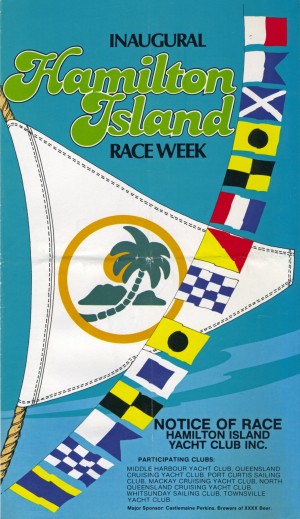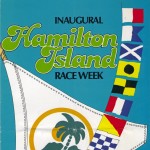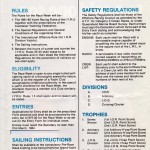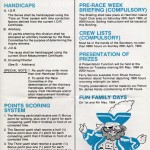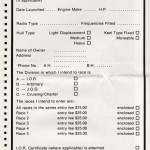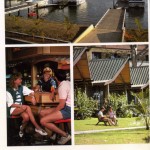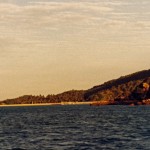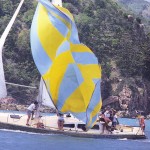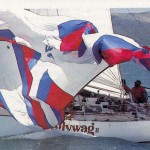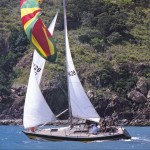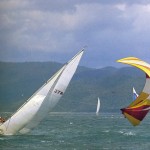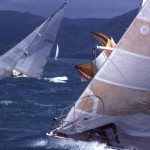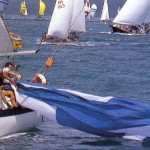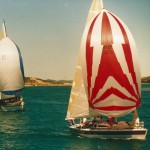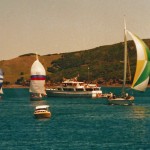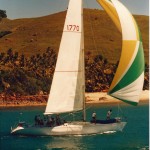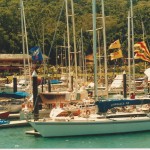| Hamilton Island Race Week | |
|---|---|
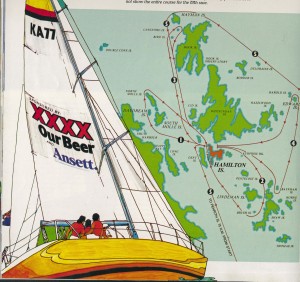 Hamilton Island 1984. The numbers on the courses are the order in which the races were sailed. | |
| Location | Hamilton Island |
| State | Queensland |
| Country | Australia |
| Club | Hamilton Island Yacht Club |
| Website | www.hamiltonislandraceweek.com.au/ |
| Facebook Site | www.facebook.com/hamiltonisland |
| Year Held From/To | 1983 to Present |
Hamilton Island Race Week
Event History www.hamiltonislandraceweek.com.au/about/race-week-history
It was during the historic America's Cup match in Newport, Rhode Island, in 1983 that Hamilton Island's developer, Keith Williams, hit on the idea of staging a major annual yacht regatta out of the island.
He discussed it at length with a friend, Rob Mundle, who was reporting on the America's Cup in Newport at that time, then, on his return to Hamilton Island, he approached a Melbourne yachtsman, David Hutchen, who was living in the Whitsunday region, and detailed his idea for the event. Hutchen seized on the concept and was subsequently commissioned by Williams to get it organised.
A few weeks later a small group, including Hutchen, Mundle, and Australia's original America's Cup challenge skipper, Jock Sturrock, were at Hamilton Island with a view to formulating the parameters for what would become the now famous Hamilton Island Race Week. With that done, Hutchen headed the organising committee that included two of his sailing mates out of Victoria, Warwick Hoban and Leon O'Donoghue.
The inaugural Hamilton Island Race Week was staged in April 1984, immediately after Easter. The response for the seven-day series was way beyond expectations: 93 yachts travelled from as far afield as Perth to be there. Unfortunately though, the weather was not what anyone had envisioned when it came to sailing in the tropics. The 'wet season' lived up to its name: rain poured down for almost the entire week. This led to the series being referred to light-heartedly as Hamilton Island Rain Week in the 'Wetsundays'. Also, the harbour-front Mardi Gras party that was staged mid-week became known as the 'Muddy Gras'.
For the first eight years, Race Week was held in April, but the impact the wet season eventually took its toll (Cyclone Aviu visited Race Week in 1989). After much consideration the organisers rescheduled Race Week for August, a time of year that promised warm weather and tradewind sailing.
One of the highlights over the first 25-plus years of Race Week was the Whitehaven Beach Party. It became the signature social event of the week, but unfortunately its fame spread beyond the regatta to the degree where it was being ambushed each year by hundreds of 'mainlanders'. The beach party was no longer the domain of competitors, their families and friends, so it had to be abandoned.
For many years, prominent sailor and famous Australian vigneron, Bob Oatley, and family members, were regular competitors at Race Week. In 2003 - the year that Bob's son, Sandy, won the Grand Prix Division with his yacht, Another Duchess - Bob was asked if he might be interested in buying the island. His positive response was almost immediate, and within weeks the family owned the island. Since then the Oatley family has taken Hamilton Island, and Race Week, to the position where both stand as icons in their respective fields in Australia, and internationally.
The 30th staging of what is now Audi Hamilton Island Race Week in 2013 was a huge success. A fleet of more than 200 yachts from Australia and overseas participated.
Every year Hamilton Island Race Week is recognised for setting new standards in the world of sailboat racing. In doing so it remains as Australia's premier regatta for offshore yachts.
1984 | In a closely fought series, Hitchhiker became the inaugural Audi Hamilton Island Race Week champion after beating Too Impetuous by one point. Interestingly, the winner of the Arbitrary Division was Marcus Blackmore with his 43-foot yacht The Manly Ferry. In comparing 'then' with 'now', it is interesting to note how the format for the racing has changed. In 1984 the distance race was a 250-mile overnighter around the Whitsunday Islands. Currently the distance race is a mere 60 miles. The Inaugural Hamilton Island Race Week - NOR 1984General Pictures Four Sea Sons in from of "Pub" at Inaugural Hamilton Island Race Week. 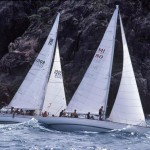 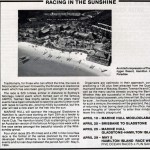 MHYC - The Log - advertising Inaugural Hamilton Island Race Week.  Thirlmere Crew in Inaugural Hamilton Island Race Week. 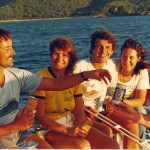 Thirlmere Crew in Inaugural Hamilton Island Race Week. 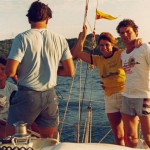 Thirlmere Crew in Inaugural Hamilton Island Race Week. 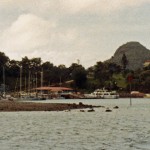 Hamilton Island 1984 Australia's Year of SAIL 1983-84, Story and Photographs by Sandy PeacockThe surprising thing about Hamilton lsland Race Week is that no-one thought of it before. The idea, of course, was modelled on the celebrated Antigua Week in the Caribbean, which is basically a week of fun in the sun, semi-serious ocean racing and a fair amount of partying. According to the plot that would have been pretty much the tone of the Hamilton lsland week. With two big maxi-yachts and several of Australia's best IOR boats present, it would also have been quite an interesting offshore series in its own right. And the whole event would have helped put Keith Williams' luxurious new Hamilton lsland resort firmly on the map. Mostly it did all work out that way, but the one element that didn'tquite fit the picture was the rain. Thanks to the presence of a stubborn south-easterly front that moved up the coast and wouldn't go away, it rained relentlessly the whole week. lt was still T-shirt weather though, because it always is in the tropics, and the sun did come bursting through the clouds every now and then just to show everyone how hot it could get. At this time of year in fact - late April - it would normally be the perfect climate in the Whitsundays. The main problem with the rain was that it turned the foreshores of Hamilton lsland's beautifully laid out boating harbour into a quagmire. This meant that when they weren't out sailing, the crews were forced to spend most of their time in the Mariners' lnn, the colonial-style pub and restaurant that's located conveniently next to the marina. Trade at the lnn was brisk. Out on the race courses the rain didn't really affect anyone too much, apart from the occasional blinding squall, because the crews were kept busy handling their boats in the gusty 20-25 knot winds that blew for most of the week. With an impressive fleet of 92 yachts turning up for this inaugural series, the starts in particular were no place for the fainthearted. Five races were sailed in the series, beginning with two 25-nautical mile courses, followed by two 35-milers, and ending with the 250-mile Coral Sea Race which took the fleet around most of the Whitsunday islands. Thanks to some sensible thinking by the race committee each race carried equal points, so it was consistency throughout the week that counted. The fleet was divided fairly evenly between the lOR and Arbitrary divisions, plus a small group of five JOG entries. ln each division the racing was remarkably close for such a wide range of designs sailing in largely unfamiliar waters. ln the IOR division - where the main competitive interest of the series was focussed - we saw the perfect cliffhanger ending. With the final race remaining, any one of five yachts could have won the series. From the crews' point of view, Hamilton lsland Race Week looks like becoming one of the star attractions of Australian ocean racing. To start with, it fits in neatly at the end of the three long "feeder" races up the NSW and Queensland coasts each autumn... Sydney-Mooloolaba, Brisbane-Gladstone and Gladstone- Hamilton lsland. lt's also very much a lighthearted series without the intensity of team competitions like the Southern Cross Cup. lnstead of the usual Olympic triangle courses the five Hamilton races weave through the delightfully scenic islands and clear green waters of the Whitsunday Passage. And back on Hamilton lsland, whether you're sleeping on the yachts or ashore, you have access to all the facilities of a top-class international resort. Especially the bars. From the owners' point of view, Hamilton lsland beckons as exactly the sort of place you always wanted to take your yacht except that you were too busy racing it back home. From the navigator's point of view, it's either a challenge to show your skill or a mortal terror, depending on how late you stayed up the night before. Although the waters of the Whitsundays are quite safe if you follow your charts and take your time, that doesn't always happen under racing conditions when the tactician, the helmsman and the owner are all yelling at you simultaneously and the basic thrust of their message is "get us out of this bloody tide". The Whitsunday tides are legendary; so too are the cauldrons thrown up in some parts of the coastline when strong tide meets strong wind. However there are also a lot of rocks and coral heads lurking under those clear green waters and they're not all necessarily where the charts say they are. The net result of all of this was a few loud bangs and dented keels during the inaugural Hamilton lsland Race Week. From the point of view of the sponsors, Ansett and Castlemaine Perkins (XXXXbeer), a lot of people flew to Hamilton lsland during the week and a lot of people drank beer. Both companies will again sponsor the series in l 985 and they clearly have confidence that it's going to be big. From Keith Williams' point of view, he not only has the premier resort and boating harbor in the Whitsundays, he now has a major ocean racing tournament (and potential social event) too. And from a spectator's point of view, or anyone wielding a camera, this first Hamilton lsland Week was dynamite. The Whitsunday islands themselves are a visual feast, with their unusual combination of Aussie bush and pine trees above the water, white sand and coral below it, and miles of rugged coastline interspersed with some of the nicest beaches you could ever want to go get marooned on. Add to that a big fleet of ocean racing yachts charging around the islands in windy conditions and you've really got something. There were some exhilarating broaches in the early races that definitely deserved awards. ln the first race, one of the Arbitrary division yachts gave the best exhibition of spinnaker-prawning l've ever seen, and in race two Graeme Lambert's Too lmpetuous lay down for about a minute in a wipeout-broach that probably cost her a place in the race. And since she finished a very close second overall, it probably cost her the series. The most unforgettable sight of the series was Jack Rooklyn's maxi Apollo just after the start of race four. Powering into 25 knots of breeze, she hit a bad patch of broken water where the ocean swells were cresting against the tide. ln, the space of about 10 waves she lifted half her huge hull clear of the water and buried it again three or four times. Undoubtedly the highlights of the week's racing were the line honors duel between the maxi-yachts, Apollo and Ragamuffin, and the battle between the top five lOR yachts to take out the series on corrected time. Here's how it went: By the day before the first race, Saturday April 28, the south-easterly front had well and truly set in and according to the local knowledge experts (i.e. anyone who had been to the Whitsundays before) it was going to be a windy week. They were right. Down at the Mariners' lnn the main interest was in the showdown between the new-model Ragamuffin and the new model Apollo. Syd Fischer's Ragamuffin, which used to be Bumblebee 4 and which had arrived at Hamilton just over 24 hours before the first race after a tight sprint from Sydney, had been lengthened to 81ft with the addition of a new stern. Apollo was also sporting a new swept-back stern, which had lengthened her from just under 72ft to 75ft 6 in. Both boats had had other major alterations too, so in a sense they were now unknown quantities. Race l, on Sunday, went all Apollo's way. The race was a 25-miler northward through the Molle Passage, around South Molle, Daydream and North Molle islands, with a hard beat back to Hamilton. Apollo jumped to an early lead after the start. Ragamuffin narrowed the gap on the run north, but was plagued with gear problems on the beat back through the Whitsunday passage into 25 knots of breeze and the full outgoing tide. ln spite of her problems, and carrying only a number 4 genoa and double-reefed main, Ragamuffln was only a minute behind the big green boat at the finish. Back in the IOR fleet the handicap stakes were looking interesting as the visiting crews learned which way to go, and not to go, in the tide. Graeme Lambert and company on Too lmpetuous picked it perfectly and the Holland Two Tonner, which has always looked fast but has had more than her share of bad luck, streaked home for an easy win. Next on corrected time was the Queensland yacht Aggression, followed by Papua Nuigini's Surefoot, and the Queensland Half Tonners Scampi A and Silver Shamrock (both former Sydney boats now doing very well up north). Then came three of the favorites for the series, Ray Johnston's Scallywag ll from Sydney, Bruce Tardrew's Admiral's Cupper Di Hard from Nuigini, and Peter Briggs' much decorated Perth Two Tonner, Hitchhiker." Race 2 got under way on Monday morning with an upwind start in heavy rainsqualls and a lumpy sea. On the 25-mile course south to seaward of Pentecost and Lindeman islands and back under kites through the Whitsunday Passage, it was once again Apollo in front in the early stages. Ragamuftin was only a length behind her as the two maxis rounded Lindeman but Apollo increased her lead with a faster kite set. Then she blew her lead by veering too far inshore into the wind shadow of Lindeman and Pentecost. With her kite filling better in the fresher breeze further out, Ragamuffin took the lead and held it for a two minute win. lt was pretty good stuff considering a long list of gear failures aboard Ragamuffin that had begun in the first race and continued on day two. Martin Leschkau and Tom Stephenson's Lexcen-designed Madame De Farge was next across the line, in the spot reserved for her as third fastest yacht in the series. On corrected time it was Noel Robins' crew on Hitchhiker that sailed the flawless race this time, and served notice that they'd be hard to beat in the races to come. Next was Silver Shamrock, Too lmpetuous, Surefoot and Inch By Winch. There was no race the next day, Tuesday, but there was alternative entertainment in the form of a dinghy-jousting contest sponsored by XXXX. This involved a large crowd gathering around the harbor foreshores while teams of three from the various yachts did battle in aluminium dinghies. To the crowd it was a great hit, to the participants it was more a matter of direct hits, and some of them were heard to suggest that rubber dinghies might be better next time. lt was the Apollo and Ragamuffin crews in the final and Apollo won. To round off the day the sponsors threw a giant party in the dockside tent, featuring a lamb roast, 7200 cans of XXXX, a very well received rock band, and mud. ln race three, a 35-mile course north to Hayman lsland and back, Apollo won the start yet again and took off on the fast kite run north with Ragamuffin close behind. She led all the way to l-layman but on the return beat Ragamuffin slipped past. Despite Hugh Treharne's valiant efforts as Apollo 's guest helmsman for the day, Ragamuffin was pointing higher and sailing faster. Weather-wise it was an interesting race, marked by alternating periods of bright tropical sunshine and total white-out rain squalls. On the water it was a routine of T-shirt, wet weather gear, T-shirt, wet weather gear, etc. Handicap honors went to the Farr fractional-rigger Scallywag ll, with Hitchhiker and Too lmpetuous continuing their private battle and finishing second and third. Surefoot and Silver Shamrock were next. After three races the first five IOR yachts were still extremely close on the pointscore. Too lmpetuous (294 points) was leading Hitchhiker (290), Surefoot (289), Silver Shamrock (288) and Scallywag ll (286). The next day it appeared that things were becoming serious when, for the first time in the series, race four began with a general recall. Two recalls in fact. On the third start the fleet got away cleanly except for Apollo, with Keith Williams aboard, which hit the starting boat, Achilles, which is Keith Williams' boat. While Apollo circled and re-started, Ragamuffin took a clear lead and slowly increased it throughout the race. That gave Ragamuffln an unbeatable three wins and the line honors title for the series. This time it was the little Holland Half Tonner Silver Shamrock that took out the lOR division, hanging in all the way on the 3 5-mile course out to sea and around Baynham and Edward islands. Next on corrected time were Scallywag ll, Hitchhiker, Di Hard and Surefoot. With only the long race to go Too lmpetuous still held her overall lead with 388 points, ahead of Silver Shamrock (also on 388 but lying second on a countback), Hitchhiker on 387, Surefoot on 384 and Scallywag II on 384 but lying fifth on the countback. This was close series-racing at its best. Just as close, though, were the outrigger canoe races held on Friday, another lay day, in the harbor. With a predictable spate of collisions and considerable steering difficulties experienced by most of the yachties, it proved almost as entertaining as the dinghy jousting. The Hamilton lsland Mens' Crew won the open division and the Ragamuffin crew won the sailors' division. For the start of the 250-miler on Saturday morning the weather went brilliantly fine for a while before closing in again at the start. Apollo took the spinnaker start again but Ragamuffin picked her up within a few miles and spent the rest of the race increasing her lead. Apollo 's big gamble early in the race, on the 75 -mile beat south to Penrith lsland, was a long tack out to seaward of Pentecost lsland looking for wind and a stronger incoming tide. lt proved a big loser and Ragamuffin had stretched out to a nine-mile lead at Penrith. According to Rob Mundle on board Rags, the big white boat really hit full stride for the first time in this race, relishing the shifty south-east breeze that built to 25 knots on Saturday night. She finished at just after 6.00 pm on Sunday with a lead of two hours and five minutes over Apollo. Back in the IOR fleet the top boats followed basically the same course as Ragamuffin on the work to Penrith lsland, the long run north to Holborne lsland and the beat back to the finish, diving in and out of the islands and the open water according to what the tide was doing. Finally it was Di Hard that scored a well deserved win but it was too late to lift her significantly in the overall standings. Hitchhiker, the model of consistency, finished second in the race ahead of Scallywag ll. Hitchhiker's points were enough to lift her clear of Too lmpetuous, fourth in this race, and give her the series. At the end only six points separated the first five boats. The final tally was: Hitchhiker 485 points, Too lmpetuous 484, Scallywag ll 481, Surefoot 479, and Silver Shamrock 479. ln the Arbitrary division Eric Ill won the long race but a consistent string of placings gave The Manly Ferry, from Sydney, top points overall. And in the JOG division Pandemonium 's win in this race gave her the series ahead of Tooth 'N Ale. Photographs from Australia's Year of SAIL 1983-84 by Sandy Peacock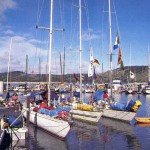 Hamilton Island 1983 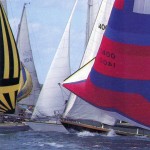 Hamilton Island 1984 - Start of first race 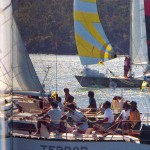 Hamilton Island 1984 - Terror 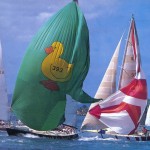 Inch by Winch, Skadaddle, Hitchhiker  Syd Fisher's Ragamuffin, now the biggest IOR maxi-yacht in Australia  Two Impetuous and Hitchhiker had their own private battle throughout the Race Week to decide the overall handicap winner. 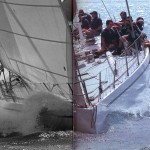 Syd Fisher's Ragamuffin, now the biggest IOR maxi-yacht in Australia, powers to windward in pursuit of Jack Rooklyn's Apollo  The fleet at rest: The crew of Joe Goddards Inch by Winch.  Inch by Winch, Skadaddle, Hitchhiker When the crews dropped their spinnakers in gusty conditions at the half way mark in Race 1, they turned on quite a show. The procedures ranged from spectacular float-drops to the more unorthodox "prawning" method. Race 2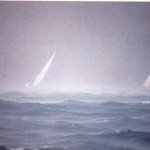 When the rain squalls blew in, they blew in hard. Race 2 gets underway in driving rain and lumpy seas. 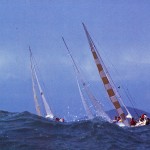 When the rain squalls blew in, they blew in hard. Race 2 gets underway in driving rain and lumpy seas. 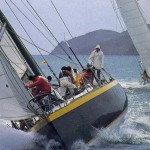 Big boat action in Race 2. Ragamuffin chases Apollo. 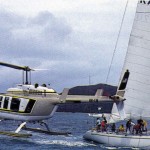 Big boat action in Race 2. A film crew chases Ragamuffin.  Big boat action in Race 2. Apollo chases her spinnaker 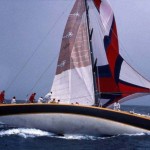 Big boat action in Race 2. Apollo chases her spinnaker More Racing Hamilton Island 1983 - Race 4 began off Catseye Beach with plenty of wind and the tide running against the seas. 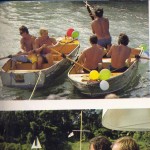 Race week organiser David Hutchinson (with the megaphone) ran dinghy-jousting contest on the lay-day after race 2 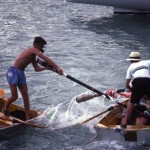 Dinghy Jousting - Photo by Sandy Peacock 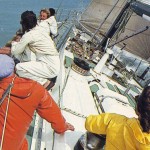 The view from on board Apollo, with Hugh Trehane sailing as guest helmsan for race three, began with Ragamuffin a few lengths astern.  Ragamuffin started a few lengths astern. It ended up with her well ahead of Apollo after a taking duel from Hayman Island back to Hamilton.  Syd Ficsher's maxi Ragamuffin, harnesses a tropical trade wind using a blooper as well as a spinnaker 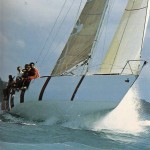 Building up speed, Hichhiker launches herself off the top of a wave 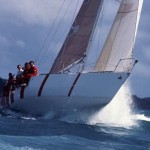 One giant leap: Peter Brigg's Hitchhiker on her way to the top of the podium - the champion yacht 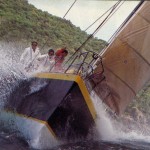 Apollo hits a patch of short, steep seas and the results are spectacular.  Apollo (75') powering through the broken water. 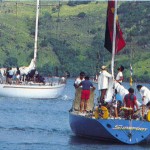 With a light breeze blowing but at lot more forecast, the crews head out for the start of the Coral Sea Race, the final and longest race of the series 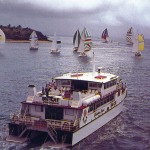 The fleet leaves Hamilton Island astern, with a 250-mile course ahead. 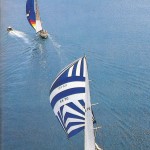 Apollo's rocket fills as she leads the way from Ragamuffin after the start |



